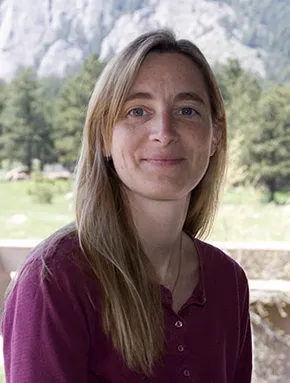Marika Holland - Senior Scientist
Revealing the role of sea ice in a changing climate

Marika Holland
Carlye Calvin/UCAR
Now a senior scientist, Marika Holland recently served as chair of the Scientific Steering Committee for the NCAR-based Community Earth System Model. Her term in that rotating position lasted from September 2011 through August 2013.
She spoke with our interviewer in the fall of 2004. Read on for a snapshot of her early career.
Marika Holland recalls that when she entered graduate school at the University of Colorado, she had "the fuzzy idea of doing something with climate." She left graduate school with a sharp focus on the role of sea ice in the climate system.
"It's an exciting field because I really like problem solving and studying complex systems to see how different parts interact," the NCAR scientist says. "And right now there's a lot of interest in the melting of sea ice due to global warming."
Sea ice forms from ocean water at high latitudes. In the Arctic region, sea ice is present all year, encompassing 4.3 to 9.3 million square miles (7-15 million square kilometers), depending on the season. In Antarctica, the ice is largely seasonal, varying between 2.4 and 12.4 million square miles (4-20 million square kilometers). Because sea ice is highly reflective, solar radiation bounces off it, keeping it cool. As the ice melts due to warmer temperatures, the reflective surface is lost. The result is a positive feedback loop that amplifies the melting process.
Marika uses computer models to analyze how sea ice fits into the climate system. She concentrates on two areas in particular: interactions between sea ice and ocean circulation patterns, and the influence of sea ice on polar climate and how this relates to global warming. "Until quite recently, most global climate models included only crude representations of sea ice," she says. "There are a lot of things that haven't been looked at yet."
Sea ice is mostly fresh water because it rejects salt back into the ocean when it freezes. When it melts, it releases that fresh water back into the system. The influx of fresh water changes the ocean's density and by extension affects its circulation patterns. "There are indications that sea ice can be important for things like the thermohaline circulation and variability in deep water," Marika says.
The thermohaline circulation, a global conveyor belt driven by variations in temperature and salinity in the oceans, plays an important role in climate regulation. It transports warm, salty water from the tropics to the North Atlantic, where it releases heat into the atmosphere and warms Western Europe. As the water cools, it sinks deep into the ocean before moving southward. According to some predictions, an increase in fresh water brought on by warmer temperatures could reduce the thermohaline circulation, thereby making Western Europe colder.
Marika is also interested in the role of sea ice in polar amplification, a phenomenon in which the planet's polar regions experience enhanced warming compared to other parts of the globe. An update to the Community Climate System Model, a global climate model that provides computer simulations of Earth's past, present, and future climate, shows a strong polar amplification. "The CCSM now has one of the better sea ice models," Marika says. "I'm very interested in understanding the polar amplification."
A math major in college, Marika always liked science. Her father, Bill Holland, was also an NCAR scientist before his retirement in 1998. "Part of the reason I did well in science was because I had a good tutor at home," Marika says. "And he was an influence on me going to graduate school." Once there, Marika's graduate adviser helped nurture her fuzzy ideas about climate into her focus on sea ice.
After completing her Ph.D. in 1997, Marika began a postdoctoral appointment at the University of Victoria in British Columbia, where she began using large-scale climate models to look at the entire northern hemisphere. Two years later, she came to NCAR for another postdoctoral fellowship and then joined the scientific staff of NCAR's Climate and Global Dynamics division.
One of Marika's biggest challenges is lack of data on sea ice. Satellites didn't start measuring the extent of the ice until the late 1970s. "We only have about 30 year's worth of observations of sea ice cover, and few observations of what is under the ice," she explains. "So it's difficult to get comprehensive data sets."
Along with the challenges, Marika especially appreciates the collaborative nature of polar sciences. "There are a lot of good people to work with," she says. "And it's nice to hope that all of this has an impact."
by Nicole Gordon
September 2004, updated August 2013